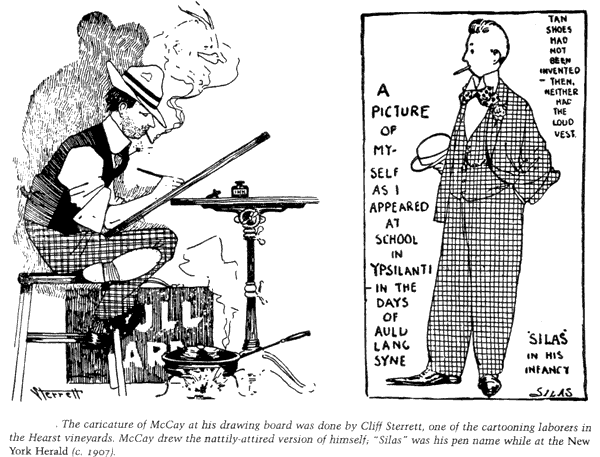The Genius of Winsor McCay
Celebrating the Centennial of the Birth of Little Nemo

Winsor McCay was the first original genius of the comic strip medium. Ditto the medium of animated cartoons. No question. He did things in both media that no one had done before. There is a fine irony in the towering stature of his genius. He had no equals; he therefore had no imitators. And no legacy.
Much of what he achieved was simply lost: like a rocket exploding brilliantly in the midnight sky, his work illuminated the medium for a breathtaking instant and then faded into virtual oblivion as, one by one, the scintillating spangles of his achievements winked out, leaving his colleagues as much in the dark as before. He was so far ahead of his time that many of his innovations were beyond the abilities of his contemporaries: what he had discovered and demonstrated about the capacities of each medium had to be re-discovered decades later by the next generation of cartoonists.
But the irony in which McCay's achievement is cloaked is an enigma of another dimension. Not only was his grasp beyond the reach of most cartoonists of his day, but he himself was prevented the full exercise of his talent for much of his career. His genius was choked off at just the moment it peaked. For most of his life, he served a master other than his muse. The story of McCay's cartooning career is therefore a record of soaring artistic aspiration and accomplishment that plummets at last, inert, all animating inventiveness suspended in order to perform humdrum graphic chores.
McCay's masterpiece in the comic strip field was—and is—Little Nemo in Slumberland. Every week, the cartoonist took us into Nemo's dreams where the young boy had fantastic adventures that ended, every week, with his startled awakening safe in his own bed. In this creation, McCay's genius, his originality, is revealed at its peak. From the very first of the Sunday pages, he was a master of the form. Nemo began on October 15, 1905, and by the next week, McCay was deploying the resources of the medium in an unconventional way for dramatic effect: Nemo dreams he is in a forest of giant mushrooms, and as he wanders into the forest, the panels expand vertically, emphasizing with their elongation the lofty height of the mushrooms.
At exactly that point, McCay had freed himself from the inhibiting confinement of the regularly rectangular grid of comic strip panels that usually prevailed on the pages of the Sunday funnies. From then on, he varied the shape and size of his panels to fit the demands of his story, using large two-tier panels (for instance) to depict the more imposing vistas of the dreamland into which Nemo wanders every week or to show an elephant or a dragon at its proper size in relation to Nemo and his friends.
McCay's use of layout and page design to give dramatic emphasis to his narrative was unusual on the comics pages of the day. Other cartoonists would not exploit this aspect of the medium with equal effect until years later.
This
44-page monograph with a dozen illustrations was produced for the Ohio State
University Cartoon Research Library’s 1998 Festival of Cartoon Art, but it
seems appropriate now, on the eve of the centennial of Little Nemo's debut,
to make the volume available again. It expands (by twice) a chapter in The Art of the Funnies to provide a history
and critical appreciation of McCay’s editorial cartooning as well as his comic
strip work in Little Nemo, Dreams of
the Rarebit Fiend, and others. Touching briefly upon McCay’s unparalleled
achievement as an animator, Harvey maintains that William Randolph Hearst,
by insisting that the cartoonist concentrate solely upon editorial cartooning,
stifled McCay’s genius. Priced at only $7, the book includes also an appreciation
of Woody Gellman, a publisher whose collection of original McCay art is archived
at the Cartoon Research Library, and a selected bibliography.
The Genius of Winsor McCay by Robert C. Harvey; 144 pages, paperback, $7 plus $4 shipping and handling; total, merely $11. Click Here to Order
art of the comic book - art of the funnies - Accidental Ambassador Gordo - reviews - rants & raves - Harv's Hindsights - return to main page
